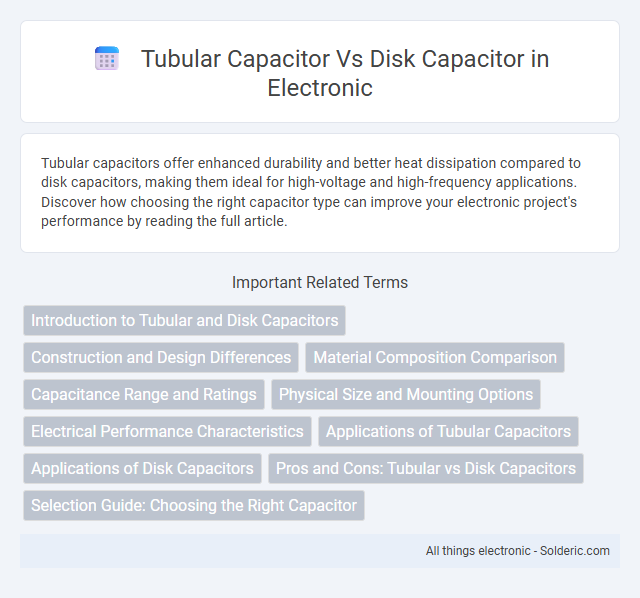Tubular capacitors offer enhanced durability and better heat dissipation compared to disk capacitors, making them ideal for high-voltage and high-frequency applications. Discover how choosing the right capacitor type can improve your electronic project's performance by reading the full article.
Comparison Table
| Feature | Tubular Capacitor | Disk Capacitor |
|---|---|---|
| Shape | Cylindrical, tube-like | Flat, disk-shaped |
| Applications | Power supplies, high-voltage circuits | Signal processing, audio circuits |
| Capacitance Range | 1 pF to several uF | Several pF to uF |
| Voltage Rating | High voltage (up to several kV) | Low to medium voltage (up to hundreds of V) |
| Dielectric Material | Mica, ceramic, paper | Ceramic, polyester |
| Size | Generally larger | Compact and thin |
| Frequency Response | Good for high-frequency applications | Suitable for audio and RF applications |
| Cost | Moderate to high | Low to moderate |
Introduction to Tubular and Disk Capacitors
Tubular capacitors feature a cylindrical shape that provides a compact design ideal for high-voltage applications, while disk capacitors are flat, circular components commonly used for lower voltage and higher frequency circuits. The construction of tubular capacitors allows for better heat dissipation and stability under load compared to disk capacitors, which excel in applications requiring minimal inductance. Your choice between tubular and disk capacitors depends on factors like voltage requirements, space constraints, and circuit frequency.
Construction and Design Differences
Tubular capacitors feature a cylindrical construction where the dielectric and electrode materials are rolled into a tube, enabling compact size and high capacitance in confined spaces. Disk capacitors have a flat, circular design with electrodes deposited on both sides of a ceramic or plastic dielectric, offering stable performance and easy mounting on PCBs. The tubular form supports higher voltage ratings and better heat dissipation, while disk capacitors excel in high-frequency applications due to their low inductance and minimal lead length.
Material Composition Comparison
Tubular capacitors utilize cylindrical metal foils and paper or plastic film dielectric materials, which contribute to compact size and efficient insulation, while disk capacitors generally consist of ceramic or plastic disks combined with metalized electrodes, enhancing high-frequency performance and stability. The choice of dielectric in tubular capacitors often results in higher capacitance density and better voltage handling, whereas disk capacitors offer superior temperature tolerance and lower parasitic inductance. Your application requirements determine whether the metal foils and film dielectrics of tubular capacitors or the ceramic disk materials of disk capacitors provide optimal performance.
Capacitance Range and Ratings
Tubular capacitors typically offer capacitance values ranging from a few picofarads to several microfarads, with voltage ratings generally between 50V and 500V, making them suitable for low to medium power applications. Disk capacitors, especially ceramic types, can achieve capacitance values from a few picofarads up to several nanofarads, with voltage ratings extending from 50V to several kilovolts, ideal for high-frequency and high-voltage environments. The choice between tubular and disk capacitors depends on the required capacitance range and voltage rating, where tubular capacitors excel in moderate capacitance and voltage, while disk capacitors cover wider voltage extremes but typically lower capacitance.
Physical Size and Mounting Options
Tubular capacitors typically have a cylindrical shape with a smaller footprint, making them suitable for compact circuit designs, whereas disk capacitors are flat and round, often occupying more surface area on printed circuit boards (PCBs). Tubular capacitors offer axial or radial lead mounting options, providing flexibility for through-hole assembly, while disk capacitors predominantly use radial leads that facilitate easy insertion into PCB holes with minimal mounting height. The choice between tubular and disk capacitors depends on space constraints and preferred mounting techniques in electronic applications.
Electrical Performance Characteristics
Tubular capacitors generally exhibit lower Equivalent Series Resistance (ESR) and higher stability under high-frequency conditions compared to disk capacitors, making them suitable for RF and high-speed applications. Disk capacitors, often ceramic, provide excellent capacitance values in compact sizes but can suffer from increased dielectric losses and reduced performance stability at elevated temperatures. The choice between tubular and disk capacitors depends heavily on application-specific requirements such as frequency response, thermal stability, and Equivalent Series Inductance (ESL).
Applications of Tubular Capacitors
Tubular capacitors are primarily used in applications requiring high stability and reliability, such as in audio equipment, radio frequency circuits, and precision timing devices. Their cylindrical shape allows for efficient heat dissipation and compact installation in electronic circuits. These capacitors excel in environments demanding low leakage current and consistent capacitance over time.
Applications of Disk Capacitors
Disk capacitors are widely used in high-frequency applications such as radio frequency circuits, audio equipment, and power supplies due to their low inductance and stable capacitance values. Their compact size and reliability make them ideal for use in oscillators, signal coupling, and filtering circuits. You will often find disk capacitors in consumer electronics, automotive systems, and communication devices where precise and consistent performance is critical.
Pros and Cons: Tubular vs Disk Capacitors
Tubular capacitors offer higher voltage ratings and better heat dissipation, making them ideal for high-power applications, but they tend to be bulkier and more expensive compared to disk capacitors. Disk capacitors are compact, cost-effective, and provide stable capacitance in low to medium voltage circuits, though they have lower voltage ratings and less thermal stability. Choosing between tubular and disk capacitors depends on the specific requirements for voltage tolerance, size constraints, and cost efficiency in the intended electronic application.
Selection Guide: Choosing the Right Capacitor
Tubular capacitors offer high capacitance values and excellent stability, making them ideal for applications requiring reliable filtering and energy storage. Disk capacitors, known for their compact size and low inductance, are better suited for high-frequency circuits and signal coupling. Evaluate your circuit's voltage, capacitance needs, and frequency response to select the right capacitor that enhances your device's performance.
tubular capacitor vs disk capacitor Infographic

 solderic.com
solderic.com